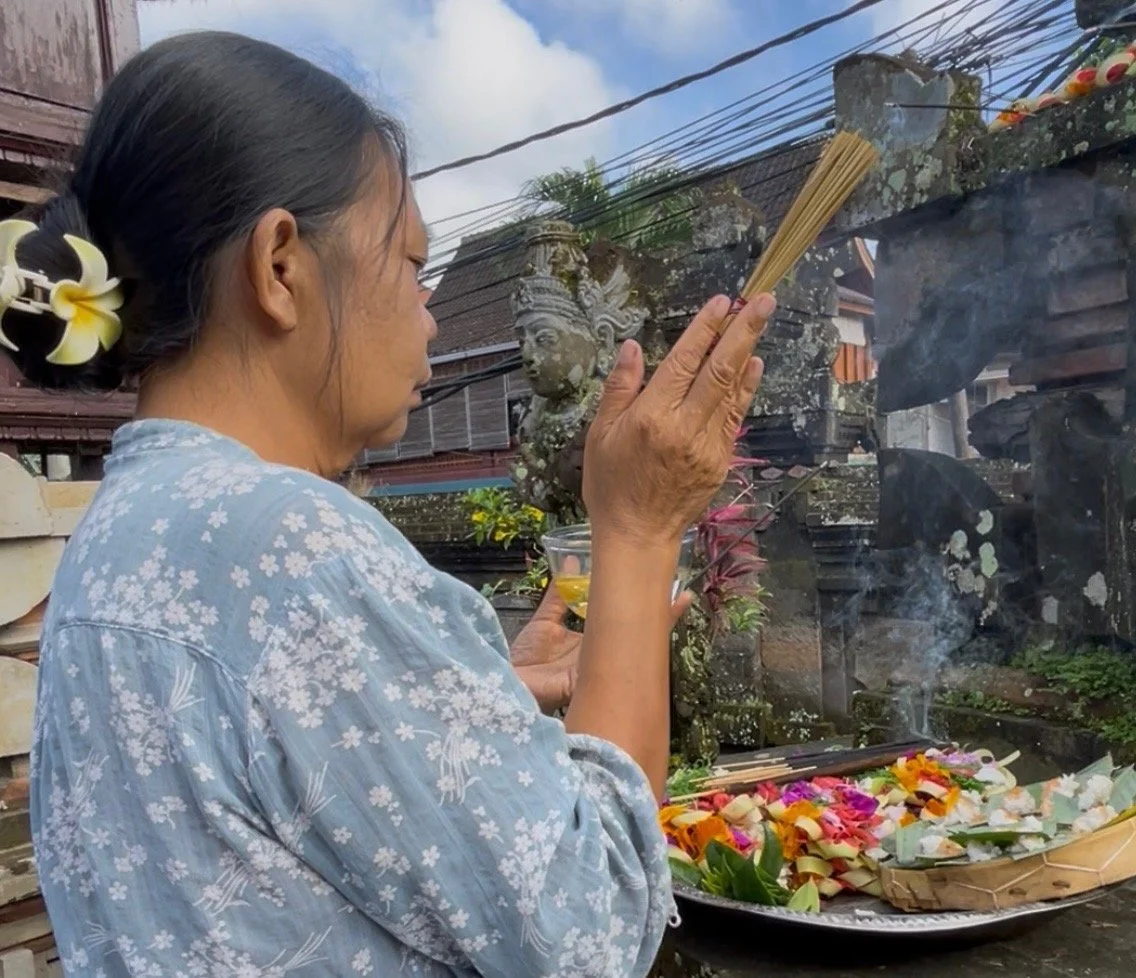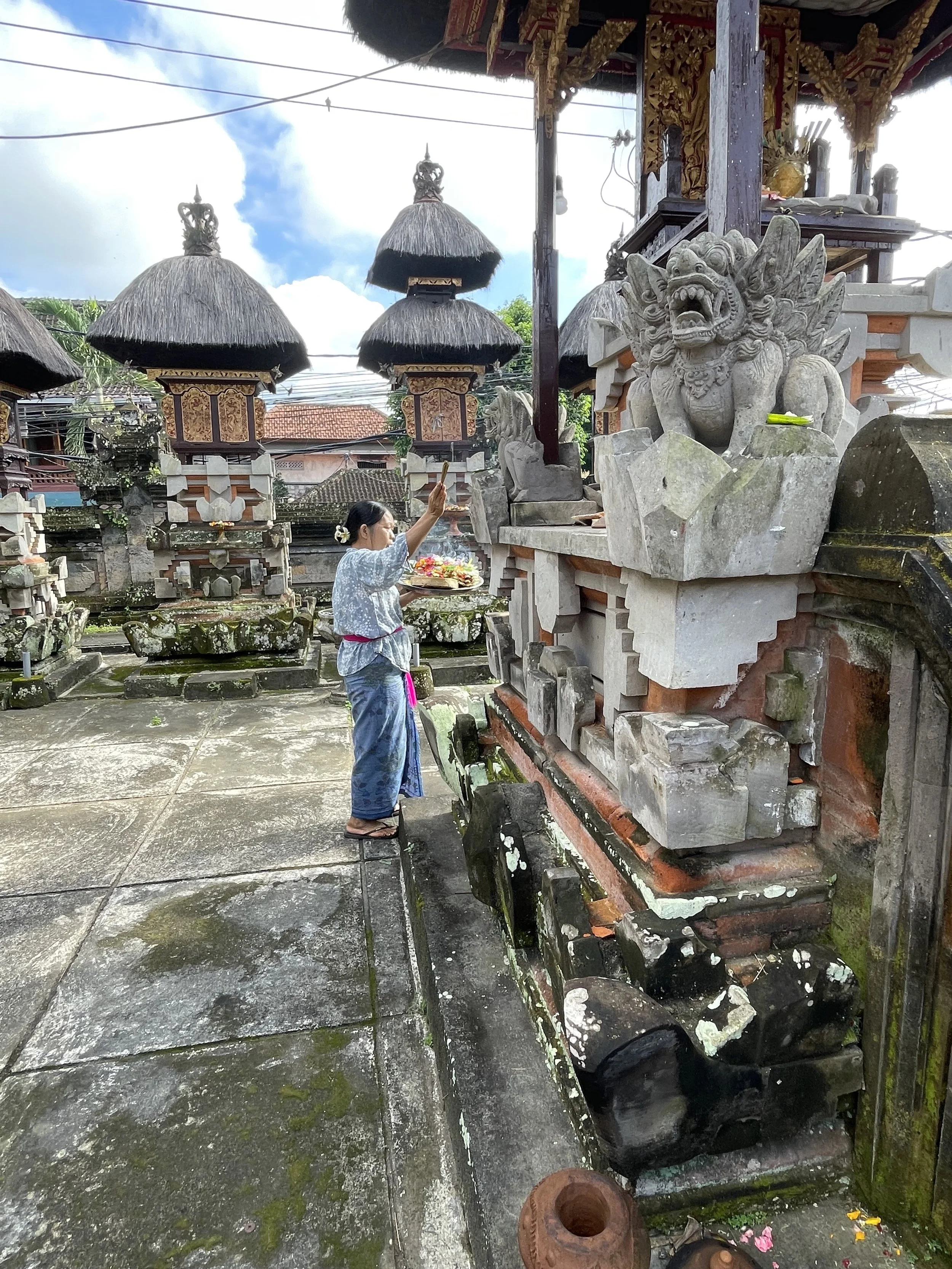A Cultural Experiment in Bali: Grokking an “Off-Puttingly Weird” Religion in Two Weeks
As cultural and religious divisiveness grows, some insights for bridging the divide
How could anyone worship an anthropomorphized elephant? I wondered.
I’VE ALWAYS FOUND HINDUISM OFF-PUTTINGLY WEIRD. The pantheon of googly-eyed gods, blue gods with crazy arms, elephants and monkeys, all seemed so foreign. Years ago, a Hindu friend invited me to his ashram in California, thinking that Hinduism might appeal to me because “you’re the joyful type.”
But nah. The chanting didn’t move me, the gods looked like the stuff of nightmares, and I was frankly creeped out by the guru lady with rolled-back eyes.
Knowing that there must be great value in a religion with 1.2 billion adherents, I asked Indian friends for help. Conceptually it was easy to grasp that Hindu gods represent different facets of one universal force. But despite my friends’ enthusiasm for the various deities they call upon in their daily lives, the conversation didn’t produce any emotional spark for me. I still didn’t get it.
Enter the crisis of cultural polarization that’s plaguing the United States.
As a Californian from a red state, I watch the progressive left and fundamentalist Christian right buy into shallow stereotypes and overt lies. We don’t give people the benefit of a doubt or explore why they believe what they do. Too often we see each other as fatally flawed instead of as normal people whose beliefs are influenced by widely varying backgrounds, experiences, and information bubbles.
So with an opportunity to spend two weeks on the Hindu-majority island of Bali, I decided this was my chance to get under the hood of Hinduism and perhaps even unlock insights for bridging cultural divides more generally.
The goal was not to become Hindu, but to see Hinduism through the eyes of those who love it. I wanted to cultivate the empathy and respect that I see missing from the American debate.
Lasti performing her daily canang sari offerings in the family temple
My first morning in Bali, I awoke to find Lasti, the lady of the house, moving quietly around the garden making small offerings. In pouring rain, Lasti put offerings on altars in the family temple, a walled section of the garden with 18 shrines. She put offerings on statues, shrubs, in the kitchen, on the front sidewalk, in each room of the house, and on every scooter in the garage.
Unhurried in a bright blue rain poncho, she placed a simple leaf, a small woven basket of flowers, a stick of incense, and a few grains of rice in each place; offerings called canang sari. Then she sprinkled holy water from a bowl holding aromatic flowers while praying intently in silence. She did this dozens of times in a compound holding some 25 structures.
On the second morning, Lasti allowed me to help, although non-family members may not perform the ritual itself. We picked frangipani flowers for the holy water, swept the temple, and Lasti made dozens of offerings with me in tow. I found it tedious by the end, but Lasti’s face was rapt for nearly one and a half hours. She seemed completely absorbed. Her expression reminded me of how I feel in a deep meditative state.
That was the beginning of my breakthrough. Lasti’s devotion and spiritual depth moved my heart.
“Rather than hating on Shiva, he’s seen as necessary to the universal balance.”
My family attended church every Sunday when I was a kid, but our lives were secular. For many Balinese, Hinduism is integrated into the fabric of daily life (I can’t speak to Hinduism in other countries, like India). Most homes have a temple, whether as big as a back yard or as small as a shelf. Women like Lasti spend time, energy, and resources on rituals they believe benefit their household and beyond, maintaining the balance between positive and negative forces. Family members help support the ritual point person, forming a symbiosis of the spiritual and practical to keep everyone safe and well.
Balance is a foundational value in Hinduism that sparked my respect. Rather than angel-and-devil style bifurcation, there is recognition of positive and negative forces co-mingling in the world. The three primary deities – Brahma the creator, Vishnu the protector, and Shiva the destroyer – are all venerated. Rather than hating on Shiva, he’s seen as necessary to the universal balance.
This is a much more realistic and compelling theology to me than everlasting hellfires for “the bad” and streets paved with gold for “the good.” (Although I left Christianity young, it remains a theological benchmark.)
Lasti described her basic prayer like this: “Thank you for your blessings. Here are flowers and rice for you. Please continue to bless us with health and prosperity.” The prayer varies according to the situation and role of the god being venerated.
Ubiquitous black and white checked fabrics remind Balinese Hindus to maintain balance between positive and negative forces. Photo taken at the public temple where Koman is a priest.
Of the shrines in Lasti’s family temple, the three that receive the first offerings are the sun god, nature, and the family’s ancestors. Other gods represent different things such as learning, the cosmic order, and water. There’s even a small shrine in a back corner for protection of the busy intersection beyond the wall.
As Lasti explained the role of each shrine, I began to understand how, together, they form an interlocking system that represents the whole of life. Without the sun, there would be nothing. Nature’s gifts flow in abundance. The ancestors worked hard and created the family.
The daily offerings are in fact small moments of mindfulness for important things that people often take for granted. I started to see the Hindu gods not as freaky, grown-up muppets, but as a set of relatable metaphors that Hindus use to move through the world with more gratitude, mindfulness, and grace.
It blew my mind that the gods could be such powerful forces in peoples’ lives even when understood as metaphor. That’s a much easier swallow than Christian literalism around Ideas like hell being a real place or communion wafers turning into Christ’s body.
Suddenly I was not only vibing with Hinduism, I was deeply appreciating its elegance. My experiment was bearing fruit!
“‘In my opinion, Hinduism is a religion of feeling, and soul returning to oneself.’”
Hinduism is everywhere in Bali; in the art and architecture, theater and dance, and ubiquitous temples. Offering baskets bedeck driveways, tree branches, hiking paths. Black and white checked fabrics symbolize the balance of forces. Red, black, and white is a common color combination representing the Trimurti, or trio, of Shiva, Vishnu, and Brahma. These are everywhere — continual reminders to stay balanced and be grateful for your blessings.
Lasti’s brother Koman, a Hindu priest, and sister Kare helped me understand the gods as tools of emotional regulation. If a believer is upset, for example, they can call upon a god with positive energy as well as offering prayers to appease a god with negative energy. Personifying the emotions helps contain them, leaving them less able to hijack the mind. And although metaphorical, calling on a higher power still helps people feel less alone with their problems. Essentially, the gods struck me as a high-EQ tool for managing tough emotions.
Said Koman, “In my opinion, Hinduism is a religion of feeling, and soul returning to oneself.”
Lasti performing the canang sari ritual in the family temple, part of a compound of about 25 shrines and buildings shared by several generations in Ubud, Bali.
Hindu concepts also influence Balinese social and economic policy, according to another of Lasti’s family members, a visual artist and gallerist named Ketut Paul who I happened to meet while gallery hopping. “Here if we have enough, we are satisfied,” Ketut said. “We don’t need more and more and more. This is why I don’t lock my door at night. I don’t worry about people stealing from me. Because we have balance.”
As I continued to marinate in Balinese Hinduism, my respect for it deepened and fondness started to grow. I watched the balance between good and evil play out in dramatic performances, I hiked a mountain where people had left hundreds of offerings to the mountain god, and I performed a powerful purification ritual in the sparkling pools of the Pura Tirta Empul water temple.
On the island of Java, after leaving Bali, I felt authentic delight at a statue of Ganesha, the elephant god who I’d always found bizarre.
My guide at the famous Prambanan temple noted that Ganesha was holding the end of his own tusk because he had broken it off to write poetry – a pretty cool move IMO. Ganesha is associated with the arts and sciences, learning and literature, removing obstacles, and new beginnings.
OMG, I would date this guy!
Suddenly I’m really jibing with a Hindu god that less than three weeks earlier I had found completely freaky. That felt like confirmation that my mission had been fulfilled. Hinduism still isn’t my religion, but I have gained respect, admiration, and even fondness for it.
So what’s the model for building cultural empathy? Here are four recommendations.
Set the right goal
Trying to understand other belief systems doesn’t mean agreeing with them – or convincing their adherents that they are wrong. The goal is simply to try to understand where they’re coming from. Maybe in the end you disagree, but you’ve gained knowledge and, ideally, respect for a different way of thinking.
2. Be humble
Assume that you don’t own the truth and there must be something reasonable behind the other side’s beliefs. Approach it as a conversation rather than a debate. A win might sound like this: “Thank you for explaining. I don’t see it that way, but I understand why you do.”
3. Get close
Cultivating cultural empathy often means seeing peoples’ expressions, hearing their voices, and watching their body language. Neurologically, we develop empathy by attuning to other peoples’ feelings, ideally in physical proximity. Kind of the opposite of a text fight or or leaving snarky comments on a social media post.
4. Learn the whole story
Belief systems come from interlocking pieces of culture: politics, education, the arts, spiritual teachings, media, community. The more facets you explore, the more you understand.
EPILOGUE
Later travels found me in a charismatic evangelical church service in North Sumatra. I figured I should give fundamentalist Christianity the same benefit of a doubt as Hinduism, despite negative past associations with it.
What I found were welcoming people singing their hearts out, and who were moved to both joy and tears over the course of the service. I used Google Lens to follow along with the service slides, which were written in Indonesian, and saw words that don’t appeal to me, like “unquenchable hellfires.”
But you know what? These folks loved it. My skeptical brain was quiet, which was not true for earlier experiences with evangelicalism.
Maybe it would have been different if I could have understood more.
But I simply felt happy to be there, and happy for them.
A charismatic evangelical Christian service on Samosir Island, North Sumatra, Indonesia




